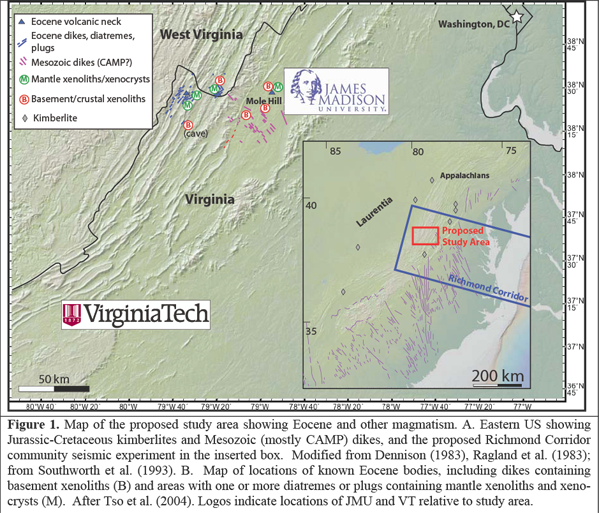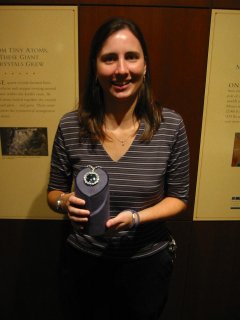Few constraints currently exist on the composition and structure of the asthenosphere and lithosphere under Eastern North America Margin (ENAM). Geochemical and petrologic data are critical for interpretation of seismic data in the region and understanding the
long-term, continued evolution of the rift-to-drift transition for ENAM, as well as for rift margins worldwide.
 |
A swarm of Eocene volcanic bodies exposed in Virginia and West Virginia are the youngest known magmatism in the Eastern U.S. and are the only petrologic window into Cenozoic processes in the mantle and lower crust in ENAM. Our project uses these magmas and mantle and basement xenoliths entrained within them to determine the depth, composition and evolution of lithospheric mantle and continental basement under ENAM. We hypothesize that: 1) The asthenosphere under ENAM is composed of enriched primitive mantle; 2) The Eocene magmas were generated through adiabatic melting of shallow asthenosphere (lithospheric delamination, edge-driven convection, or effects from deep subduction) with possible interaction with the lithosphere; 3) Mantle response to the breakup of Pangaea and/or Farallon subduction continues under this passive margin at least through the Eocene; 4) The asthenospheric mantle is relatively wet compared to the extremely dry overlying lithospheric mantle and continental basement; and 5) The lithosphere is inherited from prior orogenic and rifting events and consists of anorthosites, gneisses, and granitoids overlying metasomatized lithospheric mantle.
We are testing these hypotheses with an array of geochemical, spectroscopic,and petrologic observations and geochemical modeling. Geochronology of the melts and basement xenoliths will evaluate melting processes, constrain the structure and evolution of the
lithosphere, and evaluate the age of the volcanic activity relative to the age of the xenoliths. Our data will be used to create a vertical cross-section deep into the ENAM.
The EarthScope Transportable Array is currently deployed along the East Coast and the location of our project lies within the Richmond Transect proposed for concentrated seismic studies. Our work will provide important petrologic constraints on basement and mantle composition, lithospheric and asthenospheric structures, and volatile contents for large-scale models of the ENAM constructed from these seismic data.
Our research in the news:
Scientific American
When Was the Last Time Volcanoes Erupted on the East Coast?
http://www.scientificamerican.com/article/recent-east-coast-volcano/
The Washington Post
Hidden Depths: The Mystery of Virginia’s Extinct Volcanoes
http://www.washingtonpost.com/local/virginias-volcanic-past-mole-hill-and-trimble-knob/2012/12/15/175a6d5c-44a6-11e2-9648-a2c323a991d6_story.html?wpisrc=emailtoafriend
The Virginian-Pilot
Virginia is for... Volacnoes?
.pdf file
PBS NewsHour
Ancient Volcano Holds Clues to Earth's Deeper Mysteries
http://www.pbs.org/newshour/rundown/2010/11/ancient-volcano-holds-clues-to-earths-deeper-mysteries.html The Daily News Record
JMU Digs into a Volcano
.pdf file
|


